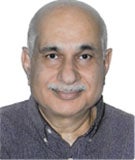Assoc Prof Sanjay Khanna
 Sanjay Khanna
Sanjay Khanna
Ph.D
Associate Professor, Department of Physiology Centre for Life Sciences
National University of Singapore
28 Medical Drive, #05-01E
Singapore 117456
Tel: 6516-3665
Email: phsks@nus.edu.sg
Other affiliations: NUS Graduate School for Integrative Sciences and Engineering
Website: https://medicine.nus.edu.sg/phys/research/research-programs/neuroscience-programme/sanjay-khanna/
https://nus.edu.sg/lsi/principal-investigators-3/assoc-prof-sanjay-khanna/
Major Research Interests
The laboratory has pioneered investigations into the role of medial septum in chronic pain. Our postulate is that the medial septum is a nodal region that modulates network mechanisms in the CNS which underpin the altered perception (i.e. hypersensitivity) and co-morbid affective and cognitive dysfunctions in chronic pain conditions. The laboratory is particularly strong in system neurobiology and using techniques for system analysis, such as in vivo electrophysiology, behaviour, in vivo imaging and optogenetics, we have begun to identify neural and neurochemical basis of the role of medial septum in experimental chronic pain. In particular, we are investigating the neural plasticity induced in pain and on medial septum manipulation. In context of foregoing, we have observed, for example, that non-cholinergic, especially GABAergic neurons in the region modulate pain-induced aversion suggesting that these neurons have a potential to play a crucial role in sustaining the aversive-fearful state of chronic pain. The effect of GABAergic neurons was related to modulation of cell signalling and translation in cortical regions. Likewise, neurokinin 1 receptor (NK1R) in MS affect aversion via modulation of cortical processing. However, interestingly, the GABAergic neurons and NK1R evoke little or no change in acute pain behaviors suggesting that that distinct neural mechanisms in the septal region sub-serve different aspects of pain. The laboratory is also closely aligned with other pre-clinical and clinical investigators in collaboration with whom we plan to work on neural and neurochemical leads identified in the laboratory for the purpose of drug discovery and technology-based management of clinical chronic pain.
Recent Publications
1. Ibrahim KM; Ariffin MZ; Khanna S (2021). Modulation of Septo-Hippocampal Neural Responses in Anesthetized and Behaving Rats by Septal AMPA Receptor Mechanisms. Frontiers in Neural Circuits Vol. 15 (22 pages), Publisher: FRONTIERS MEDIA SA, 10.3389/fncir.2021.663633.
2. Ng SY; Ariffin MZ; Khanna S (2021). Neurokinin receptor mechanisms in forebrain medial septum modulate nociception in the formalin model of inflammatory pain. Scientific Reports Vol. 11 (1) 10.1038/s41598-021-03661-6.
3. Ariffin MZ., Ibrahim KM., Lee AT-H., Lee RZ, Poon SY., Thong HK., Liu EHC., Low C-M. and Khanna S. Forebrain medial septum sustains experimental neuropathic pain. Scientific Reports 8: 11892, 08 Aug 2018.
4. Ariffin, MZ., Low, CM. and Khanna, S. Medial septum modulates cellular response induced in hippocampus on microinjection of cholinergic agonists into hypothalamic lateral supramammillary nucleus. Frontiers in Neuroanatomy 11: 79, 2017 (DOI: 10.3389/fnana.2017.00079)
5. Ang, ST., Ariffin, MZ. and Khanna, S. The forebrain medial septal region and nociception. Neurobiology of Learning and Memory 138: 238–251, 2017 (DOI:10.1016/j.nlm.2016.07.017)
6. Ang, ST., Lee, ATH., Foo, FC., Ng, L., Low, C-M. and Khanna, S. GABAergic neurons of the medial septum play a nodal role in facilitation of nociception-induced affect. Scientific Reports 5:15419, 2015 (DOI: 10.1038/srep15419)
7. Khanna, S. Nociceptive Processing in the Hippocampus and Entorhinal Cortex, Neurophysiology and Pharmacology. In R.F. Schmidt, G.F. Gebhart (eds.) ‘Encyclopedia Reference of Pain’ 2nd edition, Springer-Verlag Berlin Heidelberg, Berlin, 2013.
8. Ariffin, MZ., Chang, LS., Koh, HC., Low, C-M. and Khanna, S. An environment-dependent modulation of cortical neural response by forebrain cholinergic neurons in awake rat. Brain Research 1513: 72-84, 2013.
9. Lee, ATH., Ariffin MZ., Zhou, M., Ye JZ., Moochhala, SM. and Khanna, S. Forebrain medial septum region facilitates nociception in a rat formalin model of inflammatory pain. Pain. Vol 152, Issue 11, 2528-2542, 2011
10. Ariffin, MZB., Jiang, F., Low, C.-M. and Khanna, S. Nicotinic receptor mechanism in supramammillary nucleus mediates physiological regulation of neural activity in dorsal hippocampal field CA1 of anaesthetized rat. Hippocampus 20: 852-865, 2010
11. Zhang, S., Khanna, S. and Tang, FR. Patterns of hippocampal neuronal loss and axon reorganization of the dentate gyrus in the mouse pilocarpine model of temporal lobe epilepsy. Journal of Neuroscience Research 87: 1135–1149, 2009.
12. Zheng, F. and Khanna, S. Intra-hippocampal tonic inhibition influences formalin pain-induced pyramidal cell suppression, but not excitation in dorsal field CA1 of rat. Brain Research Bulletin 77: 374-381, 2008.
13. Wee, KS-L., Zhang, Y., Khanna, S.# and Low, C.-M. Immunolocalization of NMDA receptor subunit NR3B in selected structures in the rat forebrain, cerebellum and lumbar spinal cord. Journal of Comparative Neurology 509: 118-135, 2008.
14. Lee, ATH., Shah, JJ., Li, L., Cheng, Y., Moore, PK. and Khanna, S. A nociceptive-intensity-dependent role for H2S in the formalin model of persistent pain. Neuroscience 152: 89-96, 2008.
15. Jiang, F. & Khanna S. Microinjection of carbachol in the supramammillary region suppresses CA1 pyramidal cell synaptic excitability. Hippocampus 16: 891-905, 2006.

